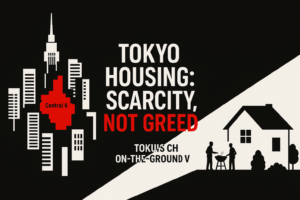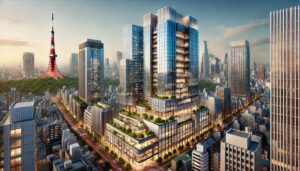
It is not greed. It is geometry—of scarce land, tighter codes, and sticky demand… with a growing taste for turnkey urban houses.
This brief draws in part on recent reporting by Nikkei on Tokyo condominium dynamics and the rise of high-end “turnkey” detached houses, alongside public datasets (Tokyo Kantei, MIC Housing & Land Survey, MLIT) and developer disclosures.
Executive Brief
-
New-build condo prices around Tokyo have hovered near JPY 100 million for three straight months; over ten years, averages are up about 62 percent, outpacing construction cost growth (~36 percent).
-
The price–cost gap widened after 2023, reflecting land scarcity, site competition, and a shift toward dual-income and asset-income buyers.
-
Crucially, recent price acceleration is concentrated in the Central 6 Wards (Chiyoda, Chuo, Minato, Shinjuku, Bunkyo, Shibuya). Other wards and suburban prefectures rose too, but less dramatically.
-
In parallel, upper-income households are trading towers for turnkey urban houses in prime low-rise neighborhoods.
-
Nationwide, most households live in detached houses, and regional cities still offer broadly affordable options versus central Tokyo.
1) Greedflation? The Data Say “Scarcity”
Sales prices have risen faster than construction costs since 2015, especially post-2023. Developers’ margins are not at bubble-era extremes; the driver is scarcity of prime land and changing buyer composition—not simple “greed.” (Nikkei background plus official series.)

2) Supply Bottlenecks: The Land Is the Message
Fewer large, releasable plots; more competition from hotels/retail; and higher land acquisition costs make launches “fewer but higher,” pulling averages up when prestige projects hit the market. (Nikkei; developer commentary.)
3) Demand Composition Has Changed
High-earning dual-income households (and pair loans) have increased markedly around Tokyo, sustaining prime-node demand even as affordability tightens elsewhere. (Nikkei; survey series.)
4) Spatial Divergence: “Central 6” vs. The Rest
The steepest condo price gains are concentrated in Central 6 Wards. April–July 2025 reading from Tokyo Kantei shows record high asking prices in the Central 6—well above 23-ward averages—underscoring a two-speed market. By contrast, the broader Greater Tokyo area (Saitama, Kanagawa, Chiba) registered milder gains.

Investor takeaway
-
In ultra-core submarkets (Central 6 prime), elasticity is low and outliers skew averages.
-
Outside the core, pricing rises, but with more sensitivity to rates, commuting calculus, and product mix.
5) The Quiet Pivot: From Towers to Turnkey Urban Houses
Upper-income buyers increasingly choose high-spec, move-in-ready houses in prime low-rise zones because of time-performance, space/privacy, and better control over monthly outlays (parking, management). (Nikkei examples; developers’ programs.)
6) “Tokyo ≠ Japan”: Household Math—and a Detached-House Nation
Japan is structurally a detached-house majority: occupied dwellings are over half single-family nationally (MIC Statistical Handbook; 2023 Housing & Land Survey). That helps explain why regional cities still offer many affordable houses relative to central Tokyo’s condo market, even with land prices rising broadly in recent years.
Practical lens
-
For families flexible on location, regional metros (and many suburban nodes) provide larger lots, drive-to-work/park lifestyle, and materially lower price-to-income ratios.
-
For investors, yield and liquidity behave differently: land-heavy houses in regional cities can cash-flow while remaining far below central-Tokyo valuations.
7) Investor Map (Three Layers)
-
Ultra-prime (JPY 200–500m+): Central 6 condos and curated houses—limited elasticity; global/domestic wealth underpin.
-
Core-prime: 2LDK 60–80 sqm condos vs 110–140 sqm houses. Condos face mortgage/rent/policy pressures; houses bifurcate by neighborhood quality (streetscape, zoning, schools).
-
Value-add: Low-rise blocks where façade coherence, greenery, driveway planning, and utility undergrounding can manufacture a neighborhood premium.
8) Risks & Scenarios
Rate path and wage growth; affordability policy focused on mid-market; and, for houses, maintenance governance and micro-location liquidity.
9) What To Do Now
-
Side-by-side: Compare an 80 sqm prime condo in the Central 6 with a 120–140 sqm turnkey house in a top low-rise district across monthly outlay, usable space, parking, privacy, and commute/school catchments.
-
Regional option set: If lifestyle allows, benchmark a regional-metro detached house alternative to quantify “space per yen.”
-
Capital recycling: Monetize tower unrealized gains into a house—model taxes/fees and parking economics.
Closing
Tokyo housing is not a morality tale—it is geometry. Central 6 scarcity, evolving households, and product innovation explain the top-end prints; Japan at large remains a house-first nation with many affordable paths outside the core.








